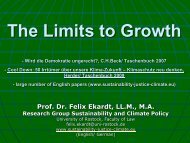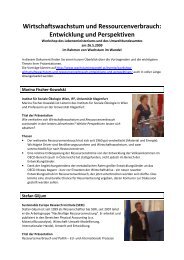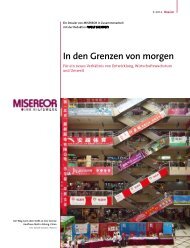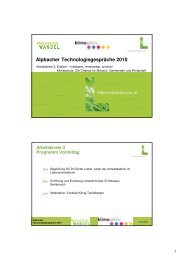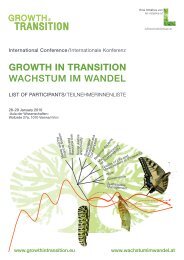Wohlstand ohne Wachstum - Wachstum im Wandel
Wohlstand ohne Wachstum - Wachstum im Wandel
Wohlstand ohne Wachstum - Wachstum im Wandel
Erfolgreiche ePaper selbst erstellen
Machen Sie aus Ihren PDF Publikationen ein blätterbares Flipbook mit unserer einzigartigen Google optimierten e-Paper Software.
Pennekamp: <strong>Wohlstand</strong> <strong>ohne</strong> <strong>Wachstum</strong> – Literaturüberblick 25<br />
Ein fortdauernder Anstieg privater Konsumausgaben ist in diesem Makromodell <strong>im</strong><br />
Gegensatz zum „Business as usual“-Szenario nicht vorgesehen, die Bevölkerungsgröße<br />
soll durch Migrationspolitik möglichst konstant gehalten werden (vgl. Kap. 4.2.1).<br />
Die aus Sicht Victors erforderlichen Politikmaßnahmen sind <strong>im</strong> Einzelnen:<br />
Investment: reduced net investment, a shift from investment in private to public goods through<br />
changes in taxation and expenditures.<br />
Labour force: stabilization through changing age structure of the population and population<br />
stabilization.<br />
Population: stabilization through changes to <strong>im</strong>migration policy.<br />
Poverty: trickle down replaced with focused anti-poverty programs that address the social determinants<br />
of illness and provide more direct income support.<br />
Technological change: slower, more discr<strong>im</strong>inating, preventative rather than end of pipe, through<br />
technology assessment and changes in the education of scientists and engineers.<br />
Government expenditures: a declining rate of increase.<br />
Trade: a stable, positive net trade balance (and diversifi cation of markets).<br />
Work week: shorter, more leisure through changes in compensation, work organization and<br />
standard working hours, and active market labour policies.<br />
Greenhouse gases: a revenue neutral carbon tax.<br />
To complement these policies:<br />
Consumption: more public goods fewer positional (status) goods through changes in taxation<br />
and marketing.<br />
Environment and resources: l<strong>im</strong>its on throughput and use of space through better land use planning<br />
and habitat protection and ecological fi scal reform.<br />
Localization: fi scal and trade policies to strengthen local economies. (Victor 2008a: 9f.)<br />
Victor weist darauf hin, dass es sich bei seinem No- (beziehungsweise Low-)Growth-<br />
Modell um keinen Steady State handelt, da einige Determinanten wie zum Beispiel die<br />
öffentlichen Investitionen nicht stabil seien, sondern wachsen müssten. Der Ökonom<br />
hält das Umsetzungspotenzial seiner Politikvorschläge für groß. Das dritte Szenario<br />
könne nicht nur in Kanada angestrebt werden, ähnliche Resultate seien auch für andere<br />
hoch entwickelte Länder zu erwarten.<br />
Kritik: Zwar orientiert sich Victor bei seinen Berechnungen sehr eng an bestehenden<br />
Makromodellen. Die Auswirkungen seiner Vorschläge auf den Geldmarkt sowie die<br />
Implikationen für den internationalen Kapitalfl uss und die Wettbewerbsfähigkeit der<br />
Volkswirtschaft lässt er aber außen vor (vgl. Victor 2008a: 18).<br />
4.1.2 Mindestwachstum unverzichtbar: Hans Christoph Binswanger<br />
Der St. Gallener Geldtheoretiker Hans Christoph Binswanger widmet sich in seiner Veröffentlichung<br />
„Die <strong>Wachstum</strong>sspirale“ (Binswanger 2009a) <strong>im</strong> ersten Argumentationsschritt<br />
der Logik des <strong>Wachstum</strong>s: Er sieht <strong>Wachstum</strong> als perpetuum mobile, das sich aus



